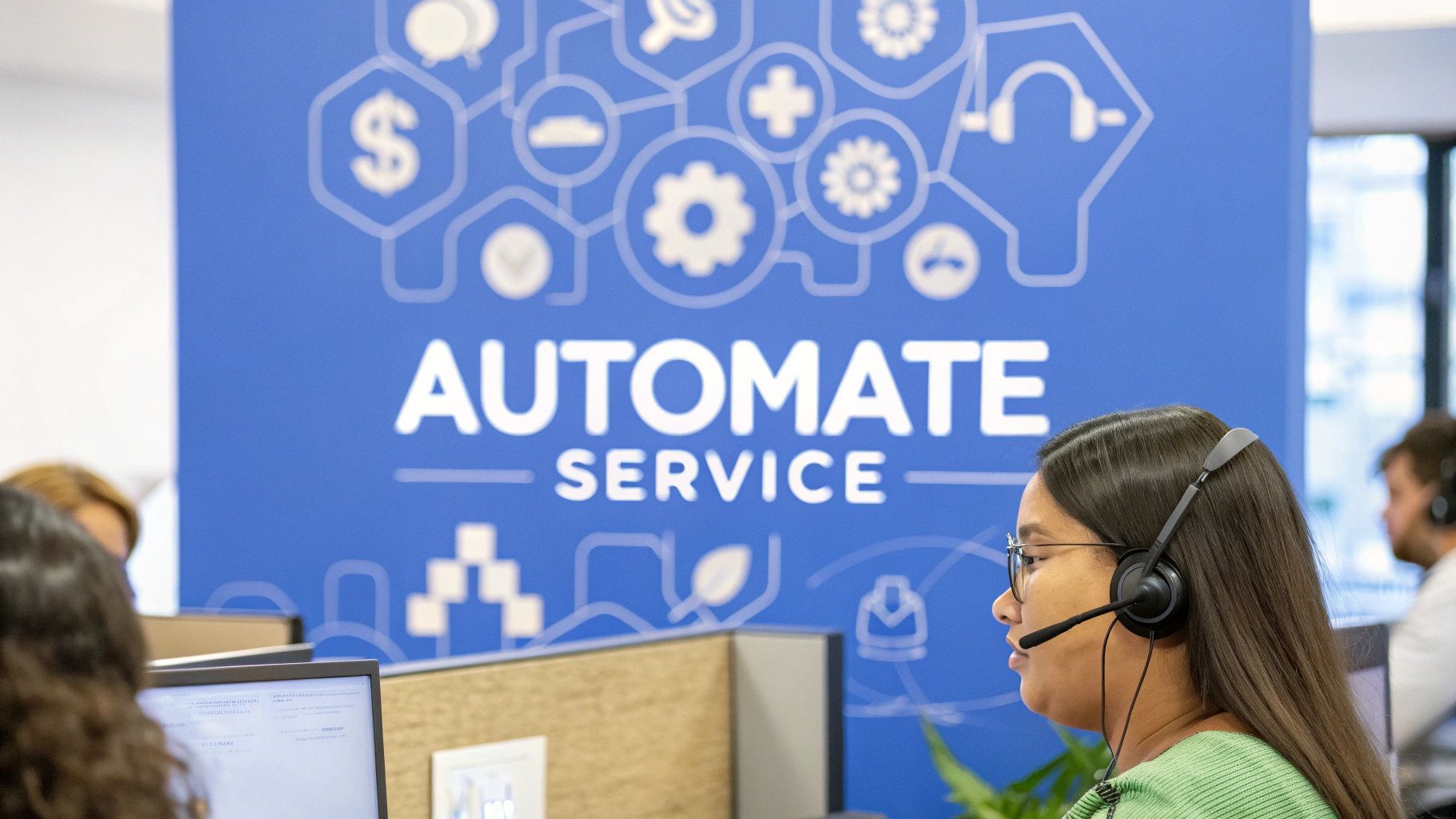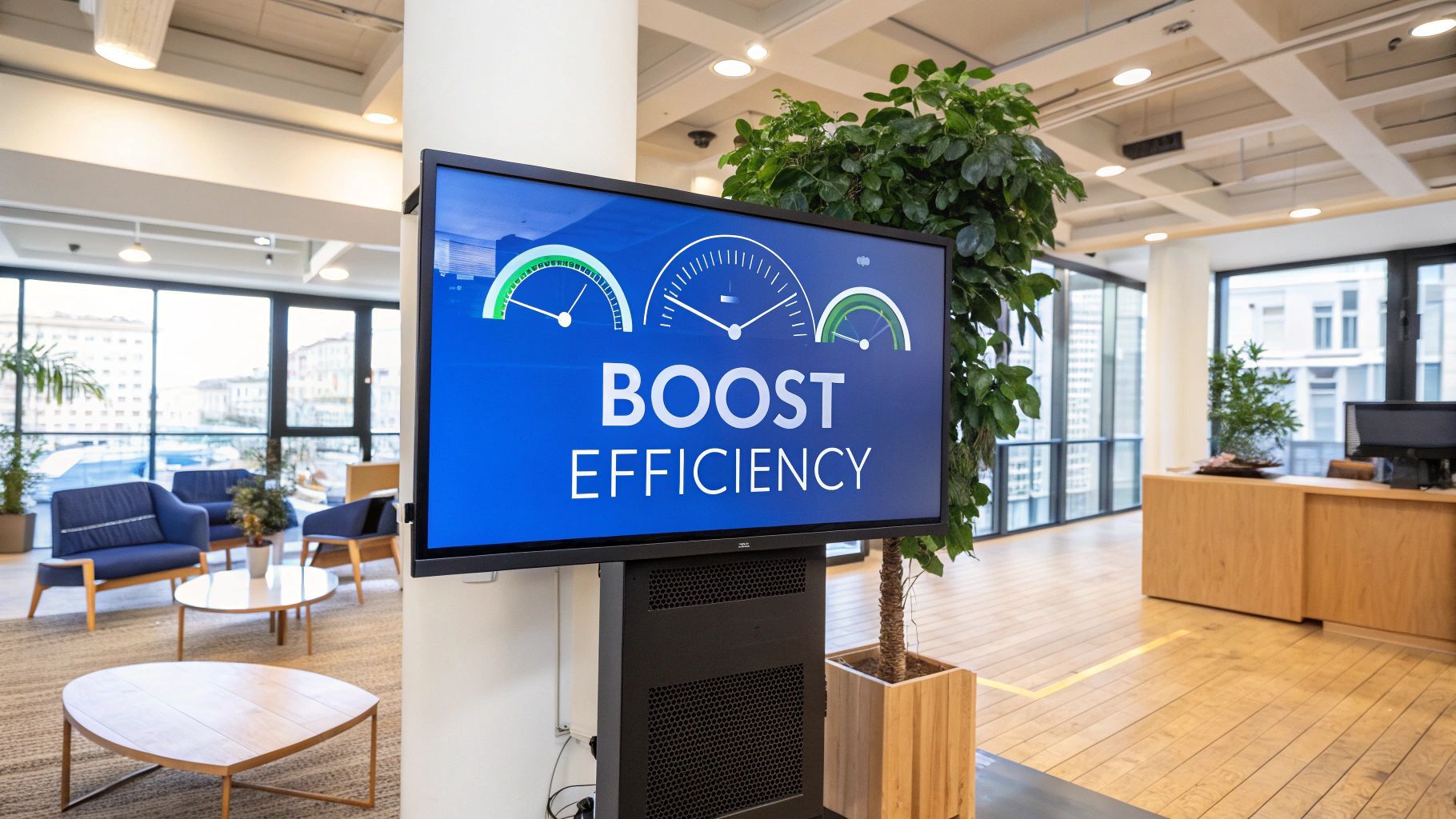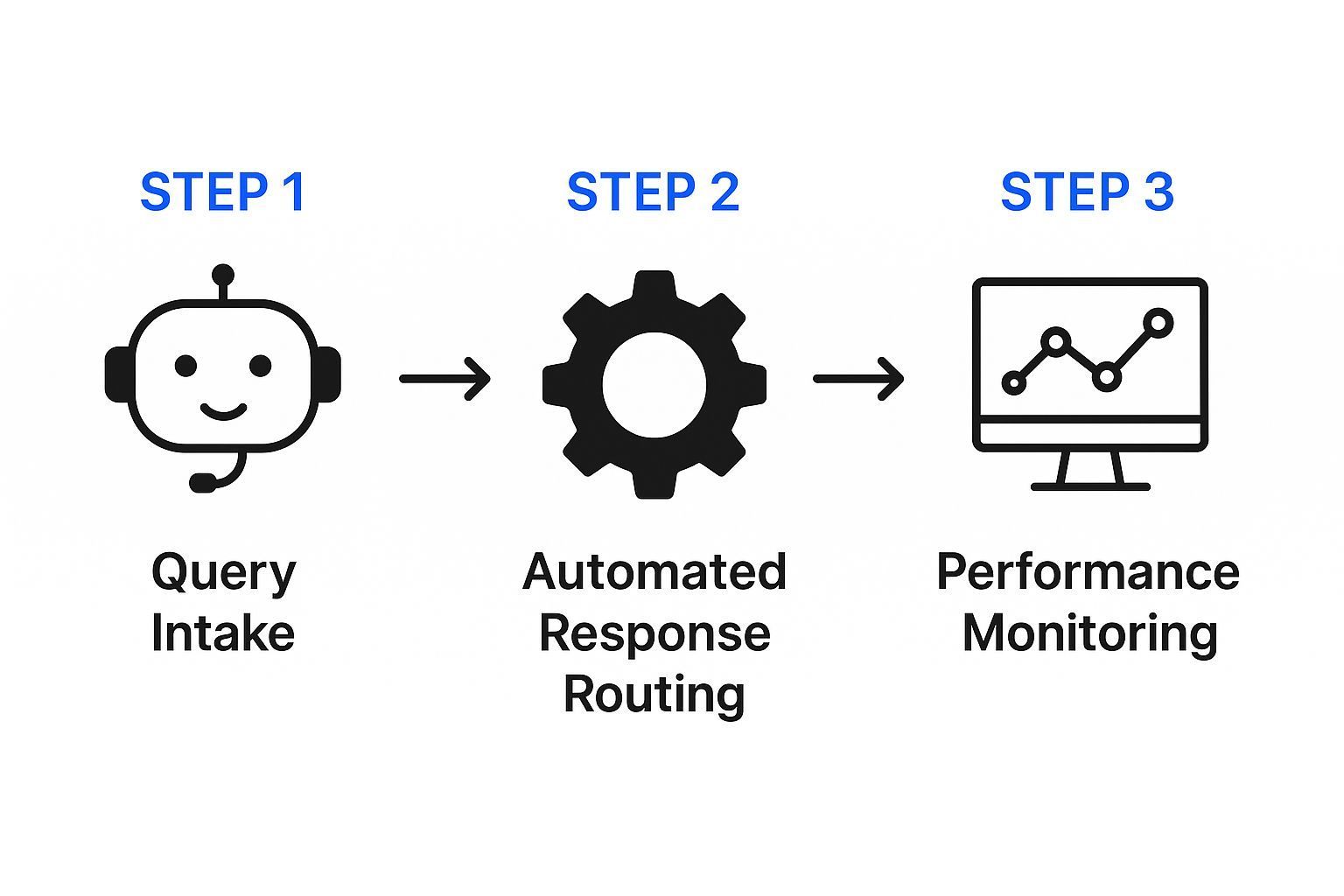
How to Automate Customer Service Effectively
Discuss with AI
Get instant insights and ask questions about this topic with AI assistants.
💡 Pro tip: All options include context about this blog post. Feel free to modify the prompt to ask more specific questions!
When we talk about automating customer service, we're really talking about using smart tech like AI and chatbots to field common customer questions and handle routine tasks. It’s all about building an efficient, 24/7 support system that takes care of the basics, which frees up your human agents to tackle the complex problems that truly need their expertise.

Let's be real—automating customer service isn't just some passing trend. It's a direct response to a massive, permanent shift in what customers expect. This isn't just about cutting costs anymore. People today demand instant answers, round-the-clock availability, and solutions that don't involve waiting on hold.
Modern AI and automation are the only ways to meet these demands at scale. The goal isn’t to create a cold, robotic experience; it's to build a system that feels genuinely helpful and seamless. In my experience, the best automation strategies enhance your team by taking over the monotonous, repetitive work, allowing your skilled agents to focus on the high-stakes conversations where they can truly make a difference.
At its heart, the push for automation is all about speed and convenience. When a customer pings you at 10 PM asking, "Where is my order?" they don't want to wait until the next morning for a reply. An AI-powered system can instantly check their order status in your Shopify or WooCommerce store and give them a real-time update.
This kind of immediate, self-service capability is exactly what builds trust and satisfaction. It shifts your support function from being purely reactive to a proactive, always-on resource for your customers.
This is a pretty big deal. In fact, by 2025, it's estimated that AI will be involved in nearly 100% of customer interactions. It’s a clear sign of just how essential automation has become. AI complements the human touch by offering 24/7 service, helping agents find answers faster, and handling all the backend administrative tasks. What's really interesting is that around half of customers now feel AI agents can show empathy, according to recent Zendesk findings, which signals a growing trust in these systems.
Key takeaway: By automatically handling the simple, high-volume questions, you give your human team the breathing room they need to deliver exceptional, empathetic support for the complex issues that build lasting customer loyalty.
A common mistake I see is businesses thinking they can just plug in a standalone chatbot and call it a day. To truly automate customer service effectively, you need a deeply integrated system. The best platforms, like our own at Spur, are designed to connect all your communication channels and business tools into a single, unified hub.
Think about this real-world scenario:
- A customer asks about your return policy through the chat widget on your website.
- The AI, which has been trained on your knowledge base, gives them an instant, accurate answer.
- The customer then says they want to start a return for a recent order.
- The AI pulls up their order history from your e-commerce platform and automatically generates a return label.
This entire exchange happens in just a couple of minutes, with zero human intervention. This is what I mean by integration—it turns a simple Q&A bot into a powerful workflow automation engine. To get a better sense of all the moving parts, you might want to check out our comprehensive guide on customer service automation. This is the kind of strategic approach that ultimately drives real business growth and keeps customers happy.
To build an automated service desk that actually works, you need to bring together several core components. It's not just about one piece of software but an ecosystem of tools and strategies working in harmony.
Component Primary Function Key Benefit AI-Powered Chatbots Provide instant answers to common questions on a 24/7 basis. Reduces ticket volume and offers immediate support, improving customer satisfaction. Unified Inbox Consolidates all customer conversations (email, chat, social media) into one view. Gives agents full context and prevents siloed communication. Knowledge Base Acts as a centralized repository of all company information and support articles. Empowers both the AI and human agents with consistent, accurate information. Workflow Automation Automates multi-step processes like returns, order tracking, and appointment scheduling. Eliminates manual tasks, reduces errors, and speeds up resolution times. CRM/E-commerce Integration Connects the support platform to customer data and order history. Enables personalized and context-aware support without needing to switch systems.
Each of these elements plays a crucial role. When they're properly integrated, they create a seamless experience for both your customers and your support team, moving you from a reactive support model to a proactive, efficient one.

It’s tempting to jump right into a shiny new automation platform, but trust me on this one: diving in without a clear strategy is a recipe for wasted time and money. Before you even think about pricing plans, you need a blueprint. This planning phase is what separates a successful automation system from a frustrating one—it ensures you're building something that actually solves problems for your customers and your support team.
The first move is to conduct a realistic audit of your current support operations. You need to get into the weeds of your customer interactions to see what’s really happening day-to-day. Don't work off assumptions; dig into the hard data sitting in your help desk or shared inbox.
Your primary goal here is to find the low-hanging fruit. I'm talking about the high-volume, repetitive questions that tie up your agents' time. These are the absolute best candidates to automate customer service processes around.
Start by digging into your support tickets from the last 30 to 60 days. Look for patterns and categorize every single inquiry. It won't take long before you see a few topics popping up again and again.
- "Where is my order?" (WISMO): This is the classic, most common question for almost every e-commerce brand.
- Return Policy Questions: Inquiries about how to start a return, who pays for shipping, or when to expect a refund.
- Product Specifications: Basic questions about an item's materials, dimensions, or compatibility.
- Shipping Information: Questions about shipping zones, costs, and delivery estimates.
Once you have this list, put some numbers to it. For example, if you discover that a whopping 40% of all incoming tickets are WISMO-related, you've just uncovered a massive opportunity. That single insight can steer your entire initial setup.
The most successful automation strategies begin with a deep understanding of existing pain points. By identifying the most frequent and time-consuming tasks, you ensure that your investment in automation will deliver an immediate and measurable impact on team efficiency and customer satisfaction.
The stakes are pretty high for getting this right. Poor customer service costs US companies an estimated $75 billion annually simply because customer expectations aren't being met. And while the potential is huge, only about 25% of call centers have fully integrated AI automation, which leaves a huge opening for businesses to get ahead. It’s also a powerful tool for your team—after all, 76% of employees report higher engagement when they feel empathy from leadership, and automation frees up your team to provide that human touch. You can discover more customer service statistics and their implications on Amplifai.
With your list of automation-ready tasks in hand, you can start setting clear, measurable goals. Vague objectives like "improve efficiency" just won't cut it. You need to focus on specific key performance indicators (KPIs) that you want to move the needle on.
A solid goal-setting framework is pretty straightforward:
- Start with an Action: What do you want to do? (e.g., Reduce, Increase, Improve)
- Define the Metric: What will you measure? (e.g., First Response Time, Ticket Volume)
- Set a Target: What’s the specific number you're aiming for? (e.g., to under 1 minute, by 30%)
- Establish a Timeline: When will you achieve this? (e.g., within 60 days)
Here are a few examples of what strong, actionable goals look like in the real world:
- Reduce first response time for all email inquiries to under 5 minutes within 30 days.
- Decrease the number of WISMO tickets handled by human agents by 70% in the first quarter.
- Increase the ticket deflection rate on our help center by 25% by automating article suggestions.
These specific goals do more than just guide your setup. They give you a clear benchmark to measure your success against later, making it easy to prove the ROI of your efforts to automate customer service and justify future investment. They also help draw the line in the sand—defining where automation ends and human expertise must take over—to keep your customer experience both helpful and personal.
Once you've mapped out what you want to automate, it’s time to pick the tools that will actually get the job done. You’ll find a whole market of options out there, from comprehensive platforms that promise to automate customer service from start to finish, to very specific chatbot builders. The real trick is to ignore the marketing fluff and zero in on what will actually work for your business.
A great automation setup isn’t about having the most features; it’s about how smoothly everything works together. Your platform of choice absolutely must play nice with the tools you already use daily, especially your CRM and e-commerce platform. It also has to be simple enough for your team to use without calling a developer, yet robust enough to handle more volume as you grow.
One of the first big decisions you'll face is whether to go for an all-in-one system or patch together a few specialized tools. Both paths have their upsides, and the best choice really comes down to your team's bandwidth and technical comfort level.
- All-in-One Platforms (like Spur): These systems bundle everything you need into one package—chatbots, a shared inbox, workflow automation, and all the necessary integrations. The huge benefit here is that everything is built to work together from the get-go, which makes setup and daily management much simpler. For most D2C brands, this is the most direct route to getting results.
- Specialized Tools: This route means you're cherry-picking the best tools for each job—a chatbot from one company, a help desk from another, and an email tool from a third. While this gives you a ton of flexibility, it can quickly lead to disconnected data and a major headache trying to get all the systems talking to each other.
This visual shows how an all-in-one platform handles a customer request from beginning to end.

As you can see, a single, integrated system can manage the entire conversation—from the initial question to the final resolution—without any awkward handoffs or delays.
It's easy to get bogged down comparing endless feature lists. After helping hundreds of brands set up their support automation, I’ve learned to focus on a few key things that truly matter. Here are the essentials:
- Seamless Integrations: Your tool has to connect directly to your core systems. If you're on Shopify, you need a bulletproof Shopify integration that can instantly pull order details, check stock levels, and kick off a return.
- No-Code Workflow Builder: You shouldn't need a developer every time you want to tweak a response. Look for a visual, drag-and-drop interface that lets your team map out conversation flows and routing rules on their own.
- Unified Multichannel Inbox: Customers reach out everywhere—email, web chat, Instagram DMs, Facebook Messenger. Your platform has to bring all these conversations into one place so your agents have the full picture.
- AI That Takes Action: Good AI doesn't just answer questions; it does things. It should be able to check an order status in your system, book an appointment, or automatically tag a conversation based on what the customer is asking.
The goal is to find a platform that empowers your team, not overwhelms them. The right tool should feel like a natural part of your operation, making it simple to build, manage, and improve how you automate customer service.
Let's get practical and tackle the most common customer question by far: "Where is my order?" (WISMO). Here’s how you’d set that up in a platform like Spur.
First, you'd create an automated workflow that listens for keywords like "order status," "tracking," or "where is it?" The AI would then politely ask the customer for their order number or email.
This is what that looks like inside the Spur dashboard. You can see how easy it is to manage existing flows or build new ones from scratch.

The interface is clean and straightforward, which means anyone on your team can build powerful automations without touching a line of code.
Once the customer provides their info, the integration with your e-commerce store (like Shopify or WooCommerce) takes over. The AI pings your store’s database, grabs the latest shipping status, and displays it right there in the chat.
If things are more complicated—maybe the package says "delivered" but the customer can't find it—you can add a rule that automatically hands the ticket over to a human agent, complete with the full chat history. This whole process takes just a few seconds and solves the customer's problem without anyone on your team lifting a finger.

Having the right tech is one thing, but the real magic begins when you build AI workflows that genuinely solve problems for your customers—without creating new ones. This is the part where you stop just having a tool and start creating a support system that makes people feel truly seen and helped.
Everything starts with a single source of truth: your knowledge base. Don’t think of it as just a pile of FAQs. It's the operational 'brain' for your entire automation system, and it has to be robust, accurate, and always up-to-date.
With that foundation, you can build out intuitive conversations and processes. The goal isn't just to close tickets; it's to guide users toward the right answers quickly and create a cohesive experience where every automated touchpoint works together.
Before you even think about designing a chatbot flow, your knowledge base needs to be completely solid. Here’s a way I like to think about it: your AI is a brilliant student, but it can only learn from the textbooks you give it. If those books are incomplete or out of date, its answers will be just plain wrong.
I've seen so many teams stumble right here. They rush to set up a slick-looking chatbot but plug it into a sparse, forgotten help center. The result? An AI that constantly defaults to, "I'm sorry, I don't understand," which is one of the quickest ways to frustrate a customer.
Your first move should be to create detailed, comprehensive articles for your top 10-15 most common customer questions—the ones you uncovered during your initial audit. Get these right, and you've handled the bulk of your volume.
- Order Tracking: Don't just link to a generic tracking page. Explain exactly how to find the tracking number and what each shipping status actually means.
- Return Process: Map out every single step. From how to start the return all the way to when they can expect to see their refund.
- Product Care: Give specific, actionable instructions. How do you wash it? Store it? What should you not do?
A well-structured knowledge base is the single most important factor in the success of your efforts to automate customer service. It directly fuels your AI, giving it the accurate information it needs to deflect tickets and solve problems on the spot.
With a strong knowledge base ready, you can start building chatbot conversations that feel less like a robot and more like a helpful guide. A huge mistake I see is creating rigid, linear scripts that feel like an interrogation. You want to build flexible, helpful flows that guide the user, not trap them.
A great chatbot conversation will always do these four things:
- Acknowledge the Issue: Show the customer you understand what they're asking for.
- Provide a Quick Answer: If possible, pull the solution directly from your knowledge base for an instant fix.
- Offer Next Steps: Don't just end the conversation. Ask if the answer was helpful or if they need something else.
- Create an Escape Hatch: Make it incredibly easy and obvious for them to connect with a human agent if they need to.
For instance, a bad flow asks a bunch of generic, qualifying questions before even trying to help. A good flow immediately understands the user's intent ("return policy"), delivers the answer, and then proactively asks, "Would you like to start a return for a recent order?" That small step turns a simple Q&A into a genuinely useful, actionable workflow.
Not all automation needs to be front-and-center. In fact, some of the most impactful workflows are the ones that happen behind the scenes to make your team's life easier. Intelligent ticket management is a perfect example of this.
Modern platforms like Spur can automatically read and analyze incoming support requests to figure out the customer's intent and sentiment. From there, the system can kick off several actions without anyone lifting a finger.
Automation Type Function Impact on Team Intelligent Tagging Automatically adds tags like return_request or damaged_item to new tickets. Agents instantly know what a ticket is about before even opening it. Smart Routing Pushes tickets to the correct team or agent based on its tag. Product questions go to the experts, while shipping issues go straight to logistics. Priority Flagging Marks tickets with negative sentiment (e.g., from words like "angry," "frustrated") as high priority. Urgent problems jump to the front of the line, preventing things from escalating.
These background automations are totally invisible to the customer, but they're absolutely essential for delivering fast, organized support. By sorting and routing every ticket automatically, you’re making sure the right person handles every issue in the right order—every single time.
Launching your AI workflows isn't the finish line—it's the starting pistol. To truly get the most out of your investment, you can't just set it and forget it. The real magic happens when you treat automation as a living system, one that needs constant attention, analysis, and refinement to get smarter over time.
This isn't about guesswork. It's about diving into the analytics inside your platform, like Spur, to see what’s truly going on. Your goal is simple: find out what’s clicking with customers, fix what’s creating friction, and uncover new ways to make your service even better.
You can't fix what you can't see. Before you even open a dashboard, you need to decide which metrics actually matter. General support numbers are one thing, but for automation, you need to track a few specific Key Performance Indicators (KPIs) that tell the real story.
Here are the essentials I always recommend focusing on:
- Containment Rate: This is the big one. It's the percentage of customer issues your AI successfully resolves without ever needing a human. A high containment rate is your clearest signal that the automation is doing its job.
- Deflection Rate: This tracks how many support requests get diverted from your human team because customers found their own answers through self-service, like a knowledge base or chatbot suggestion. It’s a direct measure of customer empowerment.
- Automation-Specific CSAT: Don't lump this in with your overall customer satisfaction scores. After an automated chat, pop a quick question like, "Did this solve your problem?" This gives you raw, unfiltered feedback on how helpful your bot actually is.
Keeping a close eye on these numbers gives you a data-backed health check. If your containment rate is slipping, for example, it's a strong hint that your chatbot scripts need a rewrite or your help articles are missing crucial details.
With your KPIs in place, your analytics dashboard becomes your command center. This is where you get your hands dirty and find out which workflows are firing on all cylinders and which are just causing headaches.
Look for patterns. For instance, maybe you see that your "Check Return Status" workflow has a sky-high escalation rate, with customers constantly asking to speak to a person. That’s a massive red flag. A little digging might reveal the AI tells them the return is "pending inspection" but never explains what that actually means, leaving customers confused and frustrated.
That kind of insight is gold. It turns a vague problem ("people are unhappy with returns") into a concrete, fixable task ("add a clear explanation of the inspection step to the return status workflow"). Being able to pinpoint and resolve these friction points is also essential for tougher situations, which is why it's so important to know how to handle customer complaints even within an automated system.
The best automation strategies are built on a constant loop of feedback and iteration. Your analytics shouldn't just be for reporting on the past—they should be your guide for actively making your system smarter with every single customer interaction.
This ongoing refinement cycle isn't just about customer happiness; it's delivering serious financial wins. Projections show that AI automation is on track to deliver a 30% decrease in customer service operational costs by 2025. On top of that, experts predict conversational AI will slash contact center labor costs by as much as $80 billion globally by 2026. This momentum is driving huge growth, with the chatbot market alone expected to expand by over $1.4 billion in 2025. You can find more of these AI-driven growth insights on Desk365.io.
Analytics tell you what went wrong, but A/B testing helps you figure out why. It's a straightforward but incredibly effective way to fine-tune your automated interactions. Instead of guessing which chatbot greeting works best, you can test it with real data.
For example, you could run a simple test on two different welcome messages:
- Version A: "Hi! I'm your virtual assistant. How can I help you today?"
- Version B: "Hello! I can help with order tracking, returns, and product questions. What can I do for you?"
You might discover that Version B, being more direct and setting clear expectations, boosts your containment rate by 15%. That's a small tweak that delivers a major improvement. Apply this same experimental mindset to everything from your knowledge base titles to email subject lines and chatbot buttons to keep making your system better and better.
Stepping into automation naturally brings up some big questions. I get it. You’re wondering what this really means for your customers, your team, and your bottom line. It's a significant move, and it's smart to be thorough.
So, let's tackle the most common concerns I hear from business owners and support managers every day. My goal is to give you straight, honest answers so you can decide what’s right for you with total confidence.
This is almost always the first question, and for good reason. No one wants to subject their customers to a frustrating bot that just says, "I don't understand." The good news is, we've come a long, long way from those old-school, rigid chatbots.
The secret is in the strategy. A well-built automation system doesn't pretend to be human. It’s designed to be an incredibly efficient assistant, delivering quick and precise answers to the questions you get over and over again. It’s transparent, helpful, and fast.
The point of automation isn’t to fake a human connection. It's to free up your real humans to create better connections. By instantly handling the simple stuff, you give your team the time they need to offer thoughtful, empathetic support on complex issues that truly need their expertise.
Think about it. When a customer pings you at 2 AM asking, "What's your return policy?" they aren't looking for a deep conversation. They just want the answer. Getting it instantly is a fantastic customer experience, not a robotic one.
This is a persistent myth, but it’s just not true anymore. Years ago, you might have needed a hefty budget and a team of developers. Today, platforms like Spur have made powerful AI automation accessible and affordable for everyone, including solo entrepreneurs and small D2C brands.
The game-changer has been the rise of no-code platforms. These tools give you a simple, visual way to build out your support workflows without touching a single line of code. You can start small—really small. Just automate one thing, like answering your top "Where is my order?" question.
For most small businesses, the math on this works out pretty quickly:
- The Cost: A reasonable monthly subscription to a platform.
- The Time Saved: Your team immediately spends less time on repetitive questions.
- The Capacity Gained: You can handle way more customer chats without hiring more people.
- The 24/7 Advantage: You’re solving problems and even capturing leads while you sleep, which often leads directly to more sales.
You’ll likely see a return on your investment in just a few months. It's a smart financial move, not a luxury expense.
This question hits on a very real fear, especially for team leaders who've built a great support culture. The best way to think about this is to see AI not as a replacement, but as a new team member—one that volunteers to handle all the most tedious tasks.
Your human agents are your problem-solving pros. Their skills are too valuable to be wasted on answering the same 5-10 questions all day. When you let AI handle those Tier 1 inquiries, you actually elevate the role of your support staff. They finally have the bandwidth to focus on more meaningful work, like:
- Solving tricky, multi-step problems that require real critical thinking.
- Calming down frustrated customers and turning a bad experience around.
- Proactively reaching out to high-value customers to build lasting loyalty.
- Analyzing customer feedback to give your product team brilliant insights.
Taking the grunt work away makes their jobs better. It helps prevent burnout and empowers them to do the high-impact work that actually builds customer relationships and pushes your business forward.
Ready to see how easily you can automate customer service without losing that personal touch? Spur provides a no-code, AI-powered platform that integrates with all your channels to deliver instant support and drive growth. Start your free 7-day trial and launch your first automation in minutes at https://www.spurnow.com.
